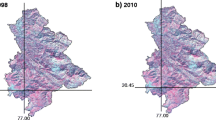Abstract
There has been a significant advancement in the application of remote sensing from various space altitudes for inventorying and monitoring ofjhum (shifting) cultivation associated forest loss. The dynamic nature ofjhum system, complex physiography, small size of individualjhum plots and their discontinuous nature of distribution, highly heterogeneous vegetation and ever-changing atmospheric condition in the Arunachal Himalaya posses a great challenge to local flora and fauna. Indian Remote Sensing (IRS)-1C/1D LISS-III data were used to classify the current and abandonedjhum areas in Dibang valley district. The amount of area occupied by current and abandonedjhum corresponds to 199.34 km2(1.53%) and 225.40 km2(1.73%) respectively. Field data were collected following stratified random sampling method to gather information on plant community occurring in abandonedjhum cultivated areas. It was observed that only nine species out of 45 contribute to 50% of the important value index (IVI). Of the 45 species, 7 species (15.56%) have been found to be endemic to Eastern Himalayas. Population inducedjhum cultivation has led to deforestation, biodiversity loss, increased surface soil erosion, and sedimentation of water bodies in this area. The potential use of satellite-derived maps can best be used for better management and land use planning.
Similar content being viewed by others
References
Anonymous, (1999). Methodology Manual: Biodiversity characterization at Landscape level using remote sensing and GIS, Indian Institute of Remote Sensing, Dehradun.
Bazzaz, F. A. (1996). Plants in Changing environments, linking physiological, population and community ecology. Cambridge University Press Cambridge.
Champion, H. G. and Seth, S. K. (1968). The forest type of India. The Manager of Publications, Delhi.
De la curz, R. E. and Vergara, N. T. (1987). Protective and ameliorative roles of agro-forestry: an overview in: Vergara NT and Briones ND (eds) Agroforesty in the humid tropics, Environmental and Policy Institute, Southeast Asian Regional center for Graduate Study, Honolulu, Hawaii.
Hajra, P. K., Verma, D. M. and Giri, G. S. (1996). Materials for the Flora of Arunachal Pradesh Vol-I (eds.), Botanical Survey of India, P-8, Brabourne Road, Calcutta, India.
Haridasan, K. and Rao, R. R. (1985). Forest Flora of Meghalaya, M/S Bishen Singh Mahendra Pal Singh, Dehradun, India.
Haridasan, K. (1996). Botanical and vernacular names of important and common forest plants of Arunachal Pradesh (ed.), Forest Bulletin 3: 1–74.
Heckadon, S. (1984). Panama’s expanding cattle front: the Santeno compressions and the colonization of the forests. Ph.D. Thesis, University of Essex, Colchester, UK
Kanjilal, U. N, Kanjilal, P. C. and Das, A. (1938). Flora of Assam. Vol. II. Published under the authority of the Government of Assam, India.
Kanjilal, U. N., Das, A., Kanjilal, P. C. and De, R. N. (1939). Flora of Assam. Vol. III. Published under the authority of the Government of Assam, India.
Kanjilal, U. N., Kanjilal, P. C, Das, A. and Purkayastha, C. (1935). Flora of Assam. Vol. I. Published under the authority of the Government of Assam, India.
Kanjilal, U. N, Kanjilal, P. C, De, R. N. and Das, A. (1940). Flora of Assam. Vol. IV. Published Under the Authority of the Government of Assam, India.
Kaul, R. N. and Haridasan, K. (1987). Forest types of Arunachal Pradesh- A preliminary study.J. Econ. Tax. Bot., 9(2): 376–389.
Mishra, R. (1969). Ecology Workbook. Oxford & IBH Publishers. Calcutta.
Muschelar, R. G and Bonnemann, A. (1997). Potential and limitation of agro-forestry for changing land use in the tropics: experience from Central America. Forest Ecology Management, 91: 61–73.
Singh, S., Singh, T. P. and Kushwaha, S. P. S.(2002). In Roy, P.S., Project Report: Biodiversity characterization at landscape level using remote sensing and geographic information system in Arunachal Pradesh Indian Institute of remote Sensing, Dehradun.
Singh T. P., Singh, Sarnam, Roy, P. S. and Rao, B. S. P. (2002). Vegetation mapping and characterization in West Siang District of Arunachal Pradesh, India - A satellite remote sensing based approach(in press).
Takhtajan, A. (1969). Flowering plants, Origin and Dispersal (Tr. Jeffery), Edinburg.
Author information
Authors and Affiliations
About this article
Cite this article
Singh, T.P., Singh, S. & Roy, P.S. Assessingjhum-induced forest loss in Dibang valley, Arunachal Himalayas — A remote sensing perspective. J Indian Soc Remote Sens 31, 3–9 (2003). https://doi.org/10.1007/BF03030746
Received:
Revised:
Issue Date:
DOI: https://doi.org/10.1007/BF03030746




